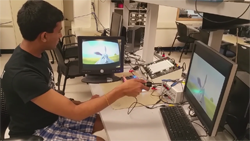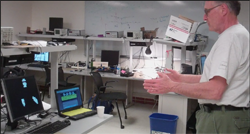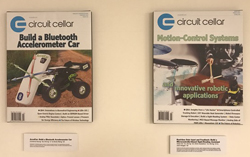ECE 4920 Contents
Course Description
Syllabus and Procedure
Note: Projects and Labs, Lecture Notes and Handouts, and Homework and Exams are not available for this course.
Procedure
The goal will be to rewrite (and perhaps extend) your final project report in ECE4760 for publication. You must have taken ECE4760 the previous Fall. To do this you will need to:
- Print out the form [PDF] required to add the course!
Form must be submitted first or second week of classes.
Typically completed at first meeting with instructor. - Pick a publication to target. Depending on the project, the target could be a computing or music magazine, or a IEEE journal or IEEE conference. I will help you choose a target publication with a reasonable chance of publication. [Only a few projects will support submission to an IEEE publication.]
- Obtain the style guide for the target publication and read it (see below for some links).
- Read some articles from the target publication.
- IF your project was a group project then you must consider the IP of your partners
and do one of:- All partners participate in this class and therefore be co-authors.
- Some partners do not participate in this class and must each specify TO ME in email one of two options:
- They will be co-authors and therefore participate in approving the writing,
but not do the writing. - They will not be co-authors and therefore will acknowledged, but not participate.
- They will be co-authors and therefore participate in approving the writing,
- Rewrite your final project report:
- Reorganize for top-down explanation of the project.
Take a step back and consider the non-specialist reader. Have a friend who is not an engineer read it. - Remove all local references (e.g. “We used Bruce’s board.”) and replace with more general statements.
- Delete the ABET-specific sections and convert it to a design narrative suitable for the target audience.
In most cases, ethics, safety, and work distribution will not be part of the final manuscript. - Find, analyze, and incorporate appropriate background publications
Build a reference list to include in the manuscript. - Reorganize, re-analyze and extend the results section of the original report, which is often written in a hasty fashion at the end of 4760.
- Follow the style guide for the target publication
- Repeat from step 1
- Reorganize for top-down explanation of the project.
- At about the third revision, make sure you are following the style guide for the target publication.
- Revise often.
- Submit the manuscript!
Time Line

- Meet to talk about strategy the first or second week of classes.
— Bring this form with you [PDF]
–Discuss the style guide(s) you have already read.
–Discuss the article(s) you have already read. - First draft due by week 4 of classes,
— meet to mark up hardcopy draft. - Second draft due by week 7 of classes,
— meet to mark up hardcopy draft. - Third draft due by week 10 of classes. As you can see, the mode number of drafts is 3.
— meet to mark up and check for following the style guide for the target publication - Fourth draft (if necessary) week 13 of classes
— meet to mark up and check for following the style guide for the target publication - Submit the manuscript and copy the instructor!
Grading
Grades will be based on:
- –Timely submission of writing drafts during the semester.
Your grade will fall if you miss a deadline! A late draft will lose one grade-step.
(A grade-step means, for instance A to A-, or B+ to B)
— A first draft which is a cut/paste hack of the course final report will lose one grade-step.
–Most manuscripts require three or four drafts, but a few may require more. - –Attention to detail (top-down explanation, grammar, sentence structure, paragraph structure).
- –Increase in draft quality with each draft.
Failure of improvement in a draft may result in loss of one or more grade-steps. - –Quality of the final draft.
- Your grade is not dependent on the manuscript being accepted for publication.


